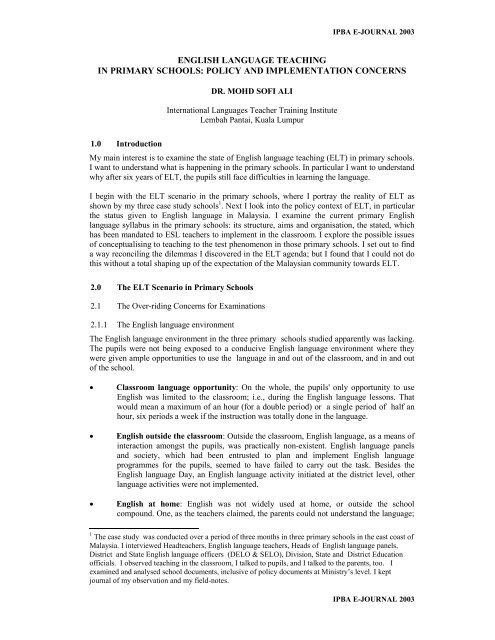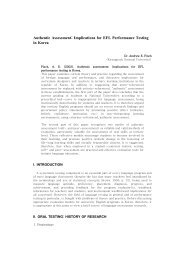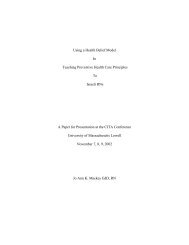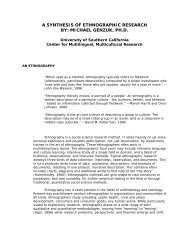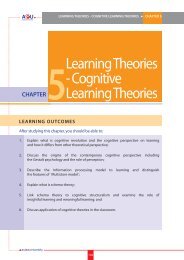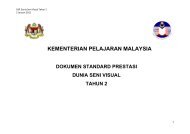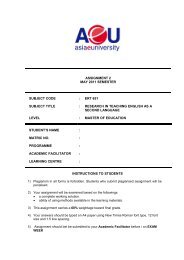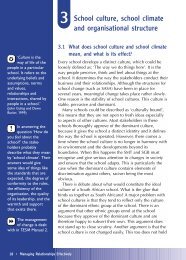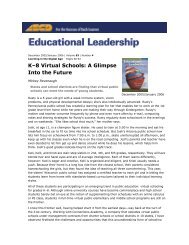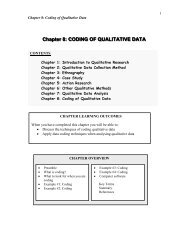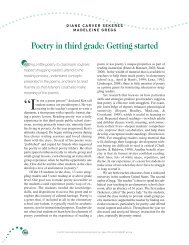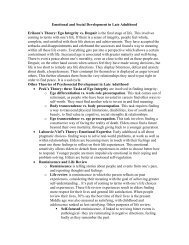english language teaching in primary schools - School Based ...
english language teaching in primary schools - School Based ...
english language teaching in primary schools - School Based ...
Create successful ePaper yourself
Turn your PDF publications into a flip-book with our unique Google optimized e-Paper software.
IPBA E-JOURNAL 2003<br />
ENGLISH LANGUAGE TEACHING<br />
IN PRIMARY SCHOOLS: POLICY AND IMPLEMENTATION CONCERNS<br />
DR. MOHD SOFI ALI<br />
International Languages Teacher Tra<strong>in</strong><strong>in</strong>g Institute<br />
Lembah Pantai, Kuala Lumpur<br />
1.0 Introduction<br />
My ma<strong>in</strong> <strong>in</strong>terest is to exam<strong>in</strong>e the state of English <strong>language</strong> <strong>teach<strong>in</strong>g</strong> (ELT) <strong>in</strong> <strong>primary</strong> <strong>schools</strong>.<br />
I want to understand what is happen<strong>in</strong>g <strong>in</strong> the <strong>primary</strong> <strong>schools</strong>. In particular I want to understand<br />
why after six years of ELT, the pupils still face difficulties <strong>in</strong> learn<strong>in</strong>g the <strong>language</strong>.<br />
I beg<strong>in</strong> with the ELT scenario <strong>in</strong> the <strong>primary</strong> <strong>schools</strong>, where I portray the reality of ELT as<br />
shown by my three case study <strong>schools</strong> 1 . Next I look <strong>in</strong>to the policy context of ELT, <strong>in</strong> particular<br />
the status given to English <strong>language</strong> <strong>in</strong> Malaysia. I exam<strong>in</strong>e the current <strong>primary</strong> English<br />
<strong>language</strong> syllabus <strong>in</strong> the <strong>primary</strong> <strong>schools</strong>: its structure, aims and organisation, the stated, which<br />
has been mandated to ESL teachers to implement <strong>in</strong> the classroom. I explore the possible issues<br />
of conceptualis<strong>in</strong>g to <strong>teach<strong>in</strong>g</strong> to the test phenomenon <strong>in</strong> those <strong>primary</strong> <strong>schools</strong>. I set out to f<strong>in</strong>d<br />
a way reconcil<strong>in</strong>g the dilemmas I discovered <strong>in</strong> the ELT agenda; but I found that I could not do<br />
this without a total shap<strong>in</strong>g up of the expectation of the Malaysian community towards ELT.<br />
2.0 The ELT Scenario <strong>in</strong> Primary <strong>School</strong>s<br />
2.1 The Over-rid<strong>in</strong>g Concerns for Exam<strong>in</strong>ations<br />
2.1.1 The English <strong>language</strong> environment<br />
The English <strong>language</strong> environment <strong>in</strong> the three <strong>primary</strong> <strong>schools</strong> studied apparently was lack<strong>in</strong>g.<br />
The pupils were not be<strong>in</strong>g exposed to a conducive English <strong>language</strong> environment where they<br />
were given ample opportunities to use the <strong>language</strong> <strong>in</strong> and out of the classroom, and <strong>in</strong> and out<br />
of the school.<br />
• Classroom <strong>language</strong> opportunity: On the whole, the pupils' only opportunity to use<br />
English was limited to the classroom; i.e., dur<strong>in</strong>g the English <strong>language</strong> lessons. That<br />
would mean a maximum of an hour (for a double period) or a s<strong>in</strong>gle period of half an<br />
hour, six periods a week if the <strong>in</strong>struction was totally done <strong>in</strong> the <strong>language</strong>.<br />
• English outside the classroom: Outside the classroom, English <strong>language</strong>, as a means of<br />
<strong>in</strong>teraction amongst the pupils, was practically non-existent. English <strong>language</strong> panels<br />
and society, which had been entrusted to plan and implement English <strong>language</strong><br />
programmes for the pupils, seemed to have failed to carry out the task. Besides the<br />
English <strong>language</strong> Day, an English <strong>language</strong> activity <strong>in</strong>itiated at the district level, other<br />
<strong>language</strong> activities were not implemented.<br />
• English at home: English was not widely used at home, or outside the school<br />
compound. One, as the teachers claimed, the parents could not understand the <strong>language</strong>;<br />
1 The case study was conducted over a period of three months <strong>in</strong> three <strong>primary</strong> <strong>schools</strong> <strong>in</strong> the east coast of<br />
Malaysia. I <strong>in</strong>terviewed Headteachers, English <strong>language</strong> teachers, Heads of English <strong>language</strong> panels,<br />
District and State English <strong>language</strong> officers (DELO & SELO), Division, State and District Education<br />
officials. I observed <strong>teach<strong>in</strong>g</strong> <strong>in</strong> the classroom, I talked to pupils, and I talked to the parents, too. I<br />
exam<strong>in</strong>ed and analysed school documents, <strong>in</strong>clusive of policy documents at M<strong>in</strong>istry’s level. I kept<br />
journal of my observation and my field-notes.<br />
IPBA E-JOURNAL 2003
IPBA E-JOURNAL 2003<br />
therefore they could not use it with the children; neither could they teach them at home.<br />
Second, the local culture, as the parents and teachers claimed, was antagonistic to the<br />
development of the English <strong>language</strong> among the pupils. Local dialect was a preferred<br />
means of communication.<br />
• Teacher’s modell<strong>in</strong>g effects: I observed that ESL teachers do not serve as an effective<br />
<strong>language</strong> role models to their pupils. The teacher’s <strong>language</strong> modell<strong>in</strong>g effect; i.e., the<br />
pupils emulat<strong>in</strong>g the <strong>language</strong> of the teachers, was remarkably lack<strong>in</strong>g <strong>in</strong> the <strong>primary</strong><br />
school context. This was particularly so because the ESL teachers themselves seldom<br />
used the <strong>language</strong> <strong>in</strong> the classroom or outside the classroom either for <strong>in</strong>structional or<br />
communication purposes. Pupil-teacher <strong>in</strong>teraction and communication were primarily<br />
effected through the local dialect than the English <strong>language</strong>. Furthermore, it was also<br />
observed that only a handful of ESL teachers <strong>in</strong>teracted and communicated with each<br />
other <strong>in</strong> English. This was partly due to the <strong>language</strong> proficiency of the ESL teachers<br />
themselves; the other be<strong>in</strong>g the tradition and workplace culture of the <strong>primary</strong> <strong>schools</strong>.<br />
2.1.2 Exam<strong>in</strong>ation results as the performance <strong>in</strong>dicator<br />
Rais<strong>in</strong>g school standards and pupils' performance took the form of improv<strong>in</strong>g target sett<strong>in</strong>g <strong>in</strong><br />
l<strong>in</strong>e with external expectations, vis-à-vis improv<strong>in</strong>g exam<strong>in</strong>ation results. English was, as I have<br />
mentioned, be<strong>in</strong>g considered as the ma<strong>in</strong> reason for the performance <strong>in</strong> the Primary <strong>School</strong><br />
Assessment Test or Ujian Penilian Sekolah Rendah (UPSR). Improvement <strong>in</strong> the performance,<br />
the ma<strong>in</strong> target of all <strong>primary</strong> <strong>schools</strong>, was therefore essentially seen as an improvement <strong>in</strong> the<br />
English <strong>language</strong> exam<strong>in</strong>ation results.<br />
The exam<strong>in</strong>ation results of <strong>primary</strong> <strong>schools</strong> were compared, charted, published <strong>in</strong> league tables<br />
and distributed to all <strong>primary</strong> <strong>schools</strong> <strong>in</strong> the district at least. The implication of the league table<br />
on the <strong>schools</strong> was detrimental. Parents, <strong>in</strong> the first place, wanted to send their pupils to the most<br />
effective <strong>schools</strong> (as judged aga<strong>in</strong>st the exam<strong>in</strong>ation results) as they wanted their children to<br />
pass <strong>in</strong> the exam<strong>in</strong>ation. Good effective <strong>schools</strong>, to them, would be those <strong>schools</strong> with more<br />
pupils scor<strong>in</strong>g five A’s <strong>in</strong> the UPSR.<br />
The school heads were worried over results atta<strong>in</strong>ed below the 40% level <strong>in</strong> the UPSR. The<br />
<strong>schools</strong> would be labelled as `low-performance <strong>schools</strong>, and they would become the centre of<br />
attention for cont<strong>in</strong>uous visits and consultations from educational authorities (national, state and<br />
district) – which was a cause for worry for all <strong>primary</strong> <strong>schools</strong>. As a result, the ma<strong>in</strong>tenance of<br />
educational standards has always be<strong>in</strong>g associated with the exam<strong>in</strong>ation results, and school<br />
heads, <strong>in</strong> particular, felt that they are answerable to the policy-makers and the other stakeholders.<br />
It becomes a big worry for the <strong>schools</strong> and publication of league table by the District Education<br />
Office (DEO) caused further concerns and a lot of preparation to raise the exam<strong>in</strong>ation results<br />
has to be made.<br />
Teachers and pupils were pressured due to the frequent tests. It was observed that education has<br />
become “learn<strong>in</strong>g for the exam<strong>in</strong>ation and not learn<strong>in</strong>g to be <strong>in</strong>telligent” for the pupils. For the<br />
teachers, it meant more clerical and adm<strong>in</strong>istrative work for them (which they had already too<br />
much of), especially <strong>in</strong> reports of exam<strong>in</strong>ation results to the DEO and to the parents.<br />
2.1.3 Focus on exam<strong>in</strong>ation classes<br />
As the over-rid<strong>in</strong>g concern was on the exam<strong>in</strong>ation, <strong>primary</strong> <strong>schools</strong> therefore focussed on the<br />
exam<strong>in</strong>ation classes; i.e., Year Six pupils. Hence, as was po<strong>in</strong>ted out <strong>in</strong> the cases, extra classes<br />
became a common phenomenon <strong>in</strong> the <strong>primary</strong> <strong>schools</strong>. They were seen as a prerequisite for<br />
excellence and quality; parents expected the extra classes to be held, and they were ever will<strong>in</strong>g<br />
to send their children to those classes. They were held <strong>in</strong> afternoons, even<strong>in</strong>gs, weekdays, and<br />
weekends and dur<strong>in</strong>g school holidays, paid or on voluntary basis. Another common academic<br />
practice was the organisation of motivational workshops and exam<strong>in</strong>ation techniques for those<br />
2
IPBA E-JOURNAL 2003<br />
pupils to prepare them for the exam<strong>in</strong>ation. Non-exam<strong>in</strong>able subjects were not given priority,<br />
and subsequently some of the periods were be<strong>in</strong>g taken by exam<strong>in</strong>ation subjects, namely English<br />
<strong>language</strong>, Bahasa Malaysia, Mathematics and Science (Lim, 1997)<br />
Pupils <strong>in</strong> the other years (Year One through Year Five), however, were left to the discretion and<br />
good judgement of the subject teachers. The <strong>School</strong> Development Plan did not <strong>in</strong>corporate a<br />
long-term academic plann<strong>in</strong>g of programmes for those classes.<br />
Year Six teachers, therefore, had to f<strong>in</strong>ish the syllabus as soon as possible. The month of May<br />
was set as the deadl<strong>in</strong>e, but teachers have been found to have f<strong>in</strong>ished it very early <strong>in</strong> the year<br />
(March). Revision ensued, and the common practice wasto prepare the pupils for the<br />
exam<strong>in</strong>ation.<br />
Extra-curricular activities apparently, were neglected <strong>in</strong> the exam<strong>in</strong>ation classes. Afternoon<br />
extra-curricular activities were replaced by extra classes for the exam<strong>in</strong>able subjects. The three<br />
<strong>primary</strong> <strong>schools</strong> were caught <strong>in</strong> the dilemma. One Headteacher noted that the importance of<br />
extra-curricular activities, as he focused on the overall excellence for his school, but despite this,<br />
priority was given to the exam<strong>in</strong>ation.<br />
2.1.4 Frequency of tests<br />
Apart from the UPSR, school-based assessment; that is, formative assessment, has been given a<br />
formal status <strong>in</strong> the policy. In practice, however, there was a heavy reliance on external<br />
standardised tests <strong>in</strong> all <strong>primary</strong> <strong>schools</strong> under study. One of these numerous tests is the UBB, a<br />
bi-monthly summative test, which is a `common practice <strong>in</strong> the three case study <strong>schools</strong>. It is<br />
designed as a part of an academic excellent strategy for the <strong>primary</strong> <strong>schools</strong>, gear<strong>in</strong>g towards the<br />
UPSR. It is organised and monitored by the Head Teachers Council, which manages the<br />
questions and distributed (sold) them to the <strong>schools</strong> at the state and district levels. The UBB<br />
would normally replace the school’s monthly or term tests, and it is meant to standardise the<br />
questions for the <strong>primary</strong> <strong>schools</strong>. It is <strong>in</strong> fact a centralisation effort aim<strong>in</strong>g to improve the<br />
quality of education, namely, the exam<strong>in</strong>ation results.<br />
Questions for the UBB were modelled along the UPSR English <strong>language</strong> paper especially for the<br />
Year Six pupils. The questions were used to drill the pupils for the actual exam<strong>in</strong>ation.<br />
Consequently, therefore, the test questions for the other years (and pupils) tended to follow that<br />
UPSR format, too.<br />
As previously noted, all pupils <strong>in</strong> all years had to sit for the test, which could be up to five times<br />
at least per calendar year. This would <strong>in</strong>clude the Year One pupils, too. They had to sit for the<br />
test as scheduled by the <strong>schools</strong>.<br />
2.2 Teach<strong>in</strong>g to the Tests Phenomenon <strong>in</strong> ELT<br />
Effective English <strong>language</strong> <strong>teach<strong>in</strong>g</strong> <strong>in</strong> the <strong>primary</strong> school, therefore, was judged by the<br />
atta<strong>in</strong>ment of the exam<strong>in</strong>ation results. ESL teachers were <strong>in</strong>deed worried and very concerned<br />
over the <strong>in</strong>puts, i.e., the pupils they had to teach. The concerns over exam<strong>in</strong>ations <strong>in</strong> the <strong>primary</strong><br />
<strong>schools</strong> has <strong>in</strong>evitably led to `<strong>teach<strong>in</strong>g</strong> to the tests’ (Norris, 1993; Nutall, 1995a).<br />
“When teacher performance is judged <strong>in</strong> terms of pupil performance on atta<strong>in</strong>ment tests<br />
teachers will tend to protect themselves aga<strong>in</strong>st the consequences of low scores and teach to the<br />
test.” (Norris, 1993;p.35)<br />
This concern with the <strong>teach<strong>in</strong>g</strong> the pupils to pass the tests and exam<strong>in</strong>ations, <strong>in</strong>stead of <strong>teach<strong>in</strong>g</strong><br />
to be <strong>in</strong>telligent has resulted <strong>in</strong> the stereotyp<strong>in</strong>g of <strong>teach<strong>in</strong>g</strong> and learn<strong>in</strong>g approaches. These<br />
would <strong>in</strong>volve us<strong>in</strong>g the first <strong>language</strong>, rote learn<strong>in</strong>g and <strong>teach<strong>in</strong>g</strong>, pattern drill<strong>in</strong>gs of questions<br />
3
IPBA E-JOURNAL 2003<br />
2.2.1 Teach<strong>in</strong>g English <strong>language</strong> <strong>in</strong> Bahasa Malaysia<br />
In all the three <strong>schools</strong>, Bahasa Malaysia, the first <strong>language</strong>, was used freely <strong>in</strong> the English<br />
<strong>language</strong> classrooms through the use of translation method. The use of the first <strong>language</strong> was a<br />
common practice among all ESL teachers (Malay and non-Malay alike) <strong>in</strong> the <strong>schools</strong>. Some<br />
ESL teachers claimed that Bahasa Malaysia had been used to a maximum of 70% <strong>in</strong> the weak<br />
classes, and 30% <strong>in</strong> the better classes. However, it was not uncommon to see 100% use of<br />
Bahasa Malaysia <strong>in</strong> the weaker classes; it would be an uncommon phenomenon to witness a<br />
100% use of English <strong>in</strong> all the classes.<br />
The ESL teachers gave two ma<strong>in</strong> reasons for this practice. Firstly, the shortage of tra<strong>in</strong>ed ESL<br />
teachers had resulted <strong>in</strong> the deployment of non-tra<strong>in</strong>ed ESL teachers to teach English <strong>in</strong> the<br />
<strong>primary</strong> <strong>schools</strong>. Apparently, some ESL teachers lacked the <strong>language</strong> proficiency and the<br />
pedagogical knowledge to teach the <strong>language</strong>. Some claimed they were not confident <strong>in</strong> their<br />
<strong>language</strong> proficiency. In fact tra<strong>in</strong>ed Malay ESL teachers admitted that they lacked the<br />
competence and confidence to use English. ESL teachers who were proficient <strong>in</strong> the <strong>language</strong>,<br />
needed pedagogical knowledge to teach English. The exam<strong>in</strong>ation concern; i.e., pass<strong>in</strong>g the<br />
exam<strong>in</strong>ation as an end product of school<strong>in</strong>g, was the second reason. Experienced ESL teachers,<br />
believ<strong>in</strong>g that their pupils would not be able to understand fully if they were taught <strong>in</strong> English,<br />
conceptualised the translation method as the most effective way to teach English <strong>language</strong> <strong>in</strong> the<br />
<strong>primary</strong> <strong>schools</strong>. The non-tra<strong>in</strong>ed ESL teachers shared the same pedagogical beliefs. The school<br />
adm<strong>in</strong>istrators concurred (some ESL teachers claimed that that was what the adm<strong>in</strong>istrators<br />
wanted) as they themselves considered high exam<strong>in</strong>ation results as the end product of education.<br />
However, a third reason, as one Headmaster and a Deputy Head observed was the reluctance of<br />
the ESL teachers to make their pupils use the <strong>language</strong>. They would consider that as a waste of<br />
time and the effort made would not pay off. To them, the easiest way to make the pupils<br />
understand what they wanted to the pupils to learn was through the translation method.<br />
Economy of time was the ma<strong>in</strong> factor. Expectation of the teachers towards the pupils'<br />
achievement <strong>in</strong> the English <strong>language</strong> would be another. The ESL teachers believed that the<br />
pupils found that English was a difficult subject to learn.<br />
Teachers' <strong>language</strong> <strong>in</strong> the classroom, as I have noted, serves as a good modell<strong>in</strong>g effect on the<br />
pupils' learn<strong>in</strong>g especially if the English <strong>language</strong> classes were the only opportunity for them to<br />
listen to the <strong>language</strong>. As Cook (1991) argued:<br />
The teacher’s <strong>language</strong> is particular importance to <strong>language</strong> <strong>teach<strong>in</strong>g</strong>…us<strong>in</strong>g the first <strong>language</strong><br />
for classroom management and <strong>in</strong>structions deprived genu<strong>in</strong>e examples of <strong>language</strong> use and set<br />
a tone for the class that <strong>in</strong>fluence much that happens <strong>in</strong> the second <strong>language</strong> activities… The<br />
whole context provides <strong>language</strong> … <strong>in</strong>cludes the patterns of <strong>in</strong>teraction between teacher and the<br />
class and between the students <strong>in</strong> the class down to the actual gestures used. The <strong>in</strong>put that the<br />
students are gett<strong>in</strong>g is far more than just the sentences they encounter.” (Cook, 1991, p.99)<br />
In addition she mentioned:<br />
“Students learn what they are taught … students learn by listen<strong>in</strong>g methods turn out to be better<br />
at listen<strong>in</strong>g; students taught through the read<strong>in</strong>g are better at read<strong>in</strong>g. The best major source of<br />
<strong>language</strong> available to the learner is what they encounter <strong>in</strong> the classroom…their <strong>language</strong> <strong>in</strong>put<br />
affects their <strong>language</strong> <strong>in</strong> broader terms.” (ibid, 1991, p.100)<br />
2.2.2 Rote learn<strong>in</strong>g, pattern and question drill<strong>in</strong>gs<br />
Typical <strong>in</strong>structional techniques used <strong>in</strong> the ESL classroom were rote learn<strong>in</strong>g and pattern<br />
drill<strong>in</strong>gs. Rote learn<strong>in</strong>g; i.e., the <strong>teach<strong>in</strong>g</strong> the rules of the <strong>language</strong>, was especially applicable to<br />
the learn<strong>in</strong>g of grammar, which was an important component of the UPSR English <strong>language</strong><br />
paper. In spite of Curriculum Development Centre’s aspiration that grammar <strong>in</strong>struction to be<br />
4
IPBA E-JOURNAL 2003<br />
implicit and covert through the use of <strong>language</strong> context (KPM, 1995), the <strong>teach<strong>in</strong>g</strong> of grammar<br />
<strong>in</strong> the <strong>primary</strong> classroom had its own twists and turns. Grammar had to be taught, expla<strong>in</strong>ed,<br />
memorised and used <strong>in</strong> sentences for exam<strong>in</strong>ation purposes.<br />
Pattern drill<strong>in</strong>gs, similarly, propelled the pupils towards the exam<strong>in</strong>ation. Familiarity of the<br />
exam<strong>in</strong>ation questions was the centre of the technique; pupils were drilled with past exam<strong>in</strong>ation<br />
questions. Repetitions were common as most teachers found that their pupils could easily forget<br />
what they had learnt previously.<br />
The familiarity of the questions had even extended to Year One pupils. They would teach the<br />
pupils the <strong>language</strong> items which would likely come out <strong>in</strong> the exam<strong>in</strong>ation (i.e., the UBB, <strong>in</strong> this<br />
case). Hence, a change of paper format would set a commotion amongst the ESL teachers (e.g.<br />
the case of Trial Exam and the <strong>in</strong>troduction of Th<strong>in</strong>k<strong>in</strong>g Skills <strong>in</strong> the English <strong>language</strong> paper).<br />
The English <strong>language</strong> learn<strong>in</strong>g and <strong>teach<strong>in</strong>g</strong> had been synonymous with <strong>teach<strong>in</strong>g</strong> to the<br />
exam<strong>in</strong>ation or test paper.<br />
2.2.3 Focus on literacy skills, neglect of oracy skills<br />
The ELT curriculum explicitly states that the oracy (listen<strong>in</strong>g and speak<strong>in</strong>g) skills should be<br />
focussed <strong>in</strong> the <strong>primary</strong> education, especially <strong>in</strong> the early years. (KPM, 1995). The pupils would<br />
be able to pick up and learn the <strong>language</strong> <strong>in</strong> a mean<strong>in</strong>gful way, and later they could be able to<br />
use that <strong>in</strong> read<strong>in</strong>g and writ<strong>in</strong>g. It is important therefore that pupils should be provided with the<br />
<strong>language</strong> before they are expected to produce it. They must also be given opportunities to try out<br />
the new <strong>language</strong> <strong>in</strong> controlled practice sessions where they have very little opportunity to make<br />
mistakes. Gradually control can be released as they are given the opportunity to use the <strong>language</strong><br />
freely. (KPM, 1995).<br />
However, as oracy skills (listen<strong>in</strong>g and speak<strong>in</strong>g) were not tested <strong>in</strong> the exam<strong>in</strong>ations (UBB or<br />
UPSR), the skills had practically been neglected <strong>in</strong> the <strong>schools</strong>. The ESL teachers claimed that<br />
the school and education authorities did not bother with the development of oracy skills <strong>in</strong> the<br />
<strong>primary</strong> <strong>schools</strong>. What counted were the literary skills, which constituted major components <strong>in</strong><br />
the UPSR English <strong>language</strong> paper.<br />
2.2.4 Learn<strong>in</strong>g English is fun, a mere slogan?<br />
Learn<strong>in</strong>g English, as envisaged <strong>in</strong> the KBSR, should be pupil-centred <strong>in</strong> order to meet the<br />
varied pupils of different abilities. As <strong>in</strong>dicated <strong>in</strong> the three cases, English <strong>language</strong> <strong>in</strong> the three<br />
case study school contexts was considered as a foreign <strong>language</strong>. In fact pupils rarely had the<br />
opportunity to use the <strong>language</strong>; the culture of the state was rather antagonistic towards the<br />
learn<strong>in</strong>g of the <strong>language</strong> itself.<br />
The KBSR English <strong>language</strong> curriculum, <strong>in</strong> pr<strong>in</strong>ciple, attempts to ensure that the pupils would<br />
acquire knowledge and skills through direct experience <strong>in</strong> learn<strong>in</strong>g the <strong>language</strong> skills. As such<br />
the major features <strong>in</strong> the <strong>teach<strong>in</strong>g</strong> and learn<strong>in</strong>g strategies <strong>in</strong>clude:<br />
• Learn<strong>in</strong>g is to be managed through a variety of group<strong>in</strong>g; a class, small group, pairs or<br />
<strong>in</strong>dividuals, appropriate to skills be taught and the diverse abilities and <strong>in</strong>terests of the<br />
pupils.<br />
• Greater diversity and flexibility is to be applied <strong>in</strong> the selection of the body of<br />
knowledge and skills to be taught <strong>in</strong> a particular lesson.<br />
• More attention to be given to the <strong>in</strong>dividual needs and <strong>in</strong>terests of pupils through<br />
remedial and enrichment programmes.<br />
• Utilisation of available local materials and resources to enhance the <strong>teach<strong>in</strong>g</strong> and<br />
learn<strong>in</strong>g process.<br />
5
IPBA E-JOURNAL 2003<br />
However, the KBSR faced several implementation setbacks. The goals have not been fully<br />
achieved. It was, an Afternoon Supervisor observed, a `paperwork culture’. It was beautiful on<br />
the paper. Apparently, the theoretical aspects of the <strong>language</strong> have been neglected. When the<br />
exam<strong>in</strong>ation became the ma<strong>in</strong> concern, stereotyp<strong>in</strong>g of <strong>teach<strong>in</strong>g</strong> and learn<strong>in</strong>g of the <strong>language</strong><br />
occurred, and classroom situations became unattractive. Pedagogy has become dry and too<br />
structured.<br />
“It is the early years of school that livel<strong>in</strong>ess, delight, a sense of magic <strong>in</strong> existence, beauty,<br />
laughter, whim and a capacity for utter foolishness are most essential and when they are present,<br />
most contagious … I urge them to be teachers so that they can jo<strong>in</strong> with the children as teacher<br />
collaborators <strong>in</strong> a plot to build a little place of ecstasy and poetry and gentle joy.” (Kozol, 1996;<br />
p.xi)<br />
3.0 English Language Teach<strong>in</strong>g Policy <strong>in</strong> Primary <strong>School</strong>s<br />
3.1 The Status and Relevance of English Language <strong>in</strong> Malaysia<br />
The policy clearly states that English <strong>language</strong> is still a strong second <strong>language</strong> <strong>in</strong> Malaysia. The<br />
<strong>primary</strong> English <strong>language</strong> syllabus, for <strong>in</strong>stance, declares:<br />
“In keep<strong>in</strong>g with the National Education Policy, English is taught as a second <strong>language</strong> <strong>in</strong> allgovernment-assisted<br />
<strong>schools</strong> <strong>in</strong> the country at both the <strong>primary</strong> and secondary levels of<br />
school<strong>in</strong>g.” (KPM, 1995, p.1)<br />
It further states:<br />
“Despite the decision to <strong>in</strong>troduce Bahasa Malaysia as the ma<strong>in</strong> medium of <strong>in</strong>struction <strong>in</strong><br />
Malaysian <strong>schools</strong>, the government however was committed to a policy of ma<strong>in</strong>ta<strong>in</strong><strong>in</strong>g English<br />
as a ‘strong second <strong>language</strong>’, <strong>in</strong> that it would be the second most important <strong>language</strong> <strong>in</strong> the<br />
country, <strong>in</strong> <strong>in</strong>ternational relations and <strong>in</strong> the economic area. This is attested to by the decision to<br />
have the English <strong>language</strong> taught as a subject from Year One of the <strong>primary</strong> school <strong>in</strong> all<br />
national <strong>primary</strong> <strong>schools</strong> and Year three of Ch<strong>in</strong>ese and Tamil <strong>schools</strong>. Also various government<br />
documents cont<strong>in</strong>ue to stress the economic, <strong>in</strong>ternational and political value of English. The<br />
Third Malaysian Plan specifically spelt out the role of English say<strong>in</strong>g: While the government<br />
will implement vigorously the <strong>teach<strong>in</strong>g</strong> of Bahasa Malaysia, measures will be taken to ensure<br />
that English is taught a strong second <strong>language</strong>. This is important if Malaysia is to keep abreast<br />
with scientific and technological developments <strong>in</strong> the world and participate mean<strong>in</strong>gfully <strong>in</strong><br />
<strong>in</strong>ternational trade and commerce (Government of Malaysia, 1976, p. 384)<br />
The policy also seeks to balance the need to preserve Bahasa Malaysia and to enhance the<br />
importance of the English <strong>language</strong>. On this, Pillay (1995) wrote:<br />
“The Cab<strong>in</strong>et Report, whilst re<strong>in</strong>forc<strong>in</strong>g the position of Bahasa Malaysia as the national and<br />
official <strong>language</strong> of the country, also emphasised the <strong>teach<strong>in</strong>g</strong> and learn<strong>in</strong>g of English as an<br />
important tool for the purpose of ga<strong>in</strong><strong>in</strong>g knowledge <strong>in</strong> the field of science and technology.”<br />
(Pillay, 1995, pp. 8-9)<br />
The importance of English lies <strong>in</strong> its economic significance<br />
“… that Malaysians might not only lose its economic competitiveness but also f<strong>in</strong>d progress <strong>in</strong><br />
the <strong>in</strong>dustrial and technical field retarded if its workforce was not competent <strong>in</strong> English.”<br />
(Mahathir Mohammad, 1991)<br />
The Education Act of 1996, which was <strong>in</strong>troduced to replace the Education Act, 1961, reaffirms<br />
the position of English as a second <strong>language</strong> <strong>in</strong> the country (MOEM, 1997) and “a compulsory<br />
6
IPBA E-JOURNAL 2003<br />
subject of <strong>in</strong>struction” (MOEM, 1996) <strong>in</strong> all <strong>schools</strong>. This was further strengthened <strong>in</strong> the Midterm<br />
review of 7 th Malaysian Plan, 1996-2000.<br />
What is the status of English <strong>in</strong> Malaysia? Is it a second <strong>language</strong>, as perceived by the policymakers,<br />
or a foreign <strong>language</strong>, as seen by the ESL teachers <strong>in</strong> the <strong>primary</strong> <strong>schools</strong>? A foreign<br />
<strong>language</strong> is not the official <strong>language</strong> of the country. It may still have a significant role to play <strong>in</strong><br />
the country: as an important school subject, a pre-requisite to enter the university or the <strong>language</strong><br />
of certa<strong>in</strong> course at the university - <strong>in</strong> tourism, bus<strong>in</strong>ess and civil services (Richards, 1985). A<br />
second <strong>language</strong>, on the other hand, is “not the mother tongue of the majority of the population,<br />
(but it) still functions as an official <strong>language</strong>; i.e., the sole or major <strong>language</strong> of law,<br />
government, education, bus<strong>in</strong>ess and media … It is used alongside the other <strong>language</strong>s, but it is<br />
commonly the most important <strong>language</strong> of education, government and bus<strong>in</strong>ess … It is often<br />
regarded by its users as a local rather than a foreign <strong>language</strong>. (Richards, 1985, p.2).<br />
I believe the status of English <strong>language</strong> <strong>in</strong> Malaysia has changed, and that English <strong>language</strong> no<br />
longer has the status of a second <strong>language</strong> (as it had ten to fifteen years ago). As my cases have<br />
<strong>in</strong>dicated, English <strong>language</strong> is most appropriately seen as a foreign <strong>language</strong>. It is just another<br />
<strong>language</strong> to be learnt besides the first <strong>language</strong>, Bahasa Malaysia.<br />
3.2 The Aims of English Language Teach<strong>in</strong>g <strong>in</strong> Primary <strong>School</strong>s<br />
English <strong>language</strong>, as a second <strong>language</strong> <strong>in</strong> the country, has a dom<strong>in</strong>ant role to play <strong>in</strong> the broader<br />
education scenario <strong>in</strong> Malaysia.<br />
“English is a means of communication <strong>in</strong> certa<strong>in</strong> everyday activities and certa<strong>in</strong> job situations. It<br />
is also an important <strong>language</strong> to enable Malaysia to engage mean<strong>in</strong>gfully <strong>in</strong> local and<br />
<strong>in</strong>ternational trade and commerce. At the same time, it also provides an additional access to<br />
academic, professional and recreational materials." (KPM, 1998b, p.2)<br />
ELT <strong>in</strong> <strong>primary</strong> education, therefore, aims at equipp<strong>in</strong>g pupils with the basic English <strong>language</strong><br />
skills (listen<strong>in</strong>g, speak<strong>in</strong>g, read<strong>in</strong>g and writ<strong>in</strong>g) and knowledge of grammar to enable them to<br />
communicate (orally and <strong>in</strong> writ<strong>in</strong>g) <strong>in</strong> and out of school for different purposes, and different<br />
situations.<br />
“English <strong>language</strong> … is be<strong>in</strong>g taught at all levels of <strong>primary</strong> school to equip the pupils with the<br />
fundamental (basic) <strong>language</strong> skills. (This is) to enable them to use the <strong>language</strong> to communicate<br />
<strong>in</strong> certa<strong>in</strong> situations. Hence, the English <strong>language</strong> programme focuses on the skills of listen<strong>in</strong>g,<br />
speak<strong>in</strong>g, read<strong>in</strong>g and writ<strong>in</strong>g.” (KPM, 1995, p.iii; translation)<br />
It is an <strong>in</strong>tegral part of the whole National Education System, which is based on the National<br />
Education Philosophy. It acknowledges that knowledge is the key determ<strong>in</strong>ant of the dest<strong>in</strong>y and<br />
survival of the nation. The purpose of education is therefore to enable the Malaysian society to<br />
have a command of knowledge, skills and values which are necessary for a highly competitive<br />
and globalised society, aris<strong>in</strong>g from the impact of rapid development <strong>in</strong> science, technology and<br />
<strong>in</strong>formation.<br />
The English <strong>language</strong> syllabus for the <strong>primary</strong> <strong>schools</strong> specifies the aims:<br />
“To equip pupils with the basic skills and knowledge of the English <strong>language</strong> so as to enable<br />
them to communicate, both orally and <strong>in</strong> writ<strong>in</strong>g, <strong>in</strong> and out of the school.” (KPM, 1995, p.1)<br />
It further outl<strong>in</strong>es:<br />
“By the end of the <strong>primary</strong> school, pupils should be able to:<br />
7
IPBA E-JOURNAL 2003<br />
i. listen to and understand simple spoken English <strong>in</strong> certa<strong>in</strong> given contexts;<br />
ii. speak and respond clearly and appropriately <strong>in</strong> familiar situations us<strong>in</strong>g simple<br />
<strong>language</strong>;<br />
iii. read and understand different k<strong>in</strong>ds of texts for enjoyment and <strong>in</strong>formation; and<br />
iv. write for different purposes and <strong>in</strong> different forms us<strong>in</strong>g simple <strong>language</strong>. (ibid, 1995,<br />
p.2)<br />
With the <strong>in</strong>troduction of the Smart <strong>School</strong> programme, where certa<strong>in</strong> <strong>primary</strong> <strong>schools</strong> <strong>in</strong> Kuala<br />
Lumpur were selected as pilot study <strong>schools</strong> <strong>in</strong> the year 2000, the aims of English <strong>language</strong><br />
<strong>teach<strong>in</strong>g</strong> and learn<strong>in</strong>g rema<strong>in</strong>s unchanged. The emphasis is still on the acquir<strong>in</strong>g the four<br />
fundamental <strong>language</strong> skills to meet the new orientation of modern technology.<br />
“(It) is to enable pupils to acquire proficiency <strong>in</strong> the <strong>language</strong> so as to equip them with positive<br />
communication skills and knowledge of English that will enable them to widen their networks of<br />
<strong>in</strong>terpersonal relations and have direct access to <strong>in</strong>formation for general knowledge and leisurebased<br />
purposes.” (KPM, 1998c, p.viii)<br />
By the end of <strong>primary</strong> education, pupils should be able to:<br />
• Establish and ma<strong>in</strong>ta<strong>in</strong> <strong>in</strong>terpersonal relations through the shar<strong>in</strong>g of <strong>in</strong>formation, ideas,<br />
op<strong>in</strong>ions, attitudes, feel<strong>in</strong>gs, experiences and plans; participate <strong>in</strong> social <strong>in</strong>teraction related<br />
to solv<strong>in</strong>g problems, mak<strong>in</strong>g arrangements, mak<strong>in</strong>g decisions with others, and obta<strong>in</strong><strong>in</strong>g<br />
good services and <strong>in</strong>formation.<br />
• Obta<strong>in</strong><strong>in</strong>g <strong>in</strong>formation from a variety of sources, and use the <strong>in</strong>formation appropriately for<br />
various purposes;<br />
• Give <strong>in</strong>formation <strong>in</strong> spoken and written forms;<br />
• Listen to, read or view and respond to stimuli;<br />
• Be <strong>in</strong>volved <strong>in</strong> spoken or written personal expressions;<br />
• Apply learn<strong>in</strong>g skills and take responsibility for their own learn<strong>in</strong>g. (ibid, 1998c, p.vii)<br />
The English <strong>language</strong> syllabus at the <strong>primary</strong> school level, therefore, comprises the <strong>teach<strong>in</strong>g</strong> of<br />
both the aural-aural skills (listen<strong>in</strong>g and speak<strong>in</strong>g) and the literacy skills (read<strong>in</strong>g and writ<strong>in</strong>g<br />
skills). A close lateral l<strong>in</strong>k is ma<strong>in</strong>ta<strong>in</strong>ed for the four <strong>language</strong> skills. (KPM, 1995).<br />
“Proficiency <strong>in</strong> the four (<strong>language</strong>) skills, namely listen<strong>in</strong>g, speak<strong>in</strong>g, read<strong>in</strong>g and writ<strong>in</strong>g is<br />
made possible through the acquisition of specific skills del<strong>in</strong>eated <strong>in</strong> each skill component.<br />
These skills are to be taught <strong>in</strong> context through selected topics together with the sound, grammar<br />
and vocabulary which form the <strong>language</strong> content. The scope for the selection of topics is<br />
specified rang<strong>in</strong>g from what is immediate and familiar to the pupils’ knowledge and experience<br />
to what is remote and unfamiliar. This is designed to foster pupils’ <strong>in</strong>terest <strong>in</strong> the English<br />
<strong>language</strong> as well as to develop a positive attitude towards it …It is emphasised that the skills,<br />
sound system, grammar and vocabulary stipulated should be taught tak<strong>in</strong>g <strong>in</strong>to account pupil<br />
ability and rate of progress. Teachers may go beyond the stipulated requirements if their pupils<br />
are capable of handl<strong>in</strong>g them.” (KPM, 1995, p.3)<br />
A total of 240 m<strong>in</strong>utes was allocated for English <strong>in</strong> Years 1 to 3 and 210 m<strong>in</strong>utes per week <strong>in</strong><br />
Years 4 to 6.<br />
3.3 Assessment <strong>in</strong> English Language Teach<strong>in</strong>g<br />
Assessments <strong>in</strong> <strong>primary</strong> education consist of two components: formative and summative (see<br />
Chapter One `Assessment Policy and Practice <strong>in</strong> Primary <strong>School</strong>s’). Formative assessment, a<br />
school-based <strong>in</strong>itiative, is a cont<strong>in</strong>uous effort on the part of the ESL teachers and the school to<br />
ensure that ELT and learn<strong>in</strong>g (i.e., the learn<strong>in</strong>g of the fundamental <strong>language</strong> skills) takes place.<br />
The summative assessment, <strong>in</strong> the form of UPSR English <strong>language</strong>, aims to assess “the<br />
8
IPBA E-JOURNAL 2003<br />
atta<strong>in</strong>ment of an <strong>in</strong>dividual at the end of a course of study” (Murphy and Broadfoot, 1995, p.36);<br />
i.e., at the end of the <strong>primary</strong> education.<br />
The UPSR English <strong>language</strong> paper aims to assess pupils' ability <strong>in</strong> the read<strong>in</strong>g, and writ<strong>in</strong>g. The<br />
1997 UPSR English <strong>language</strong> paper, for <strong>in</strong>stance, had the follow<strong>in</strong>g features:<br />
• It consisted of three sections, A, B, and C with 22 questions. Section A consisted of ten<br />
questions ; Section B another ten questions, and Section C two questions on writ<strong>in</strong>g skills.<br />
• Section A (Questions 1-10) comprises two multiple choice questions based on two<br />
comprehension passages. Passage 1 was based on a school notice and passage 2 on an<br />
<strong>in</strong>formal letter. The comprehension questions asked covered a variety of read<strong>in</strong>g sub-skills,<br />
namely the ma<strong>in</strong> idea, specific/major details, cause and effect relationships, predict<strong>in</strong>g<br />
outcomes, draw<strong>in</strong>g conclusions, vocabulary, and <strong>in</strong>ference.<br />
• Section B (Questions 11-20) was on Vocabulary and Language Usage. For Questions 11-<br />
13, three conversations were given (<strong>in</strong> the form of picture strips). The pupils were asked to<br />
choose the most suitable sentence/response (provided) to fit the situation <strong>in</strong> each of the<br />
picture. The knowledge of social functions <strong>in</strong> normal every day situations and context would<br />
be essential. The pupils were required to study each picture carefully to understand the<br />
situations and then selected the right response for the sentence given. Questions 14-15<br />
assessed the pupils on the correct use of vocabulary <strong>in</strong> a given situation. They were required<br />
to choose the correct relationship/word as <strong>in</strong>dicated by the dialogues with the word<br />
provided. Questions 16-20, were also picture-dependent, was a `modified’ cloze procedure.<br />
The pupils were required to study the pictures carefully and then they had to complete the<br />
text provided by writ<strong>in</strong>g one word for each blank. There were five blanks.<br />
• Section C, which assessed the pupils’ writ<strong>in</strong>g skills, comprised of two questions, Questions<br />
21 and 22. Question 21 was an <strong>in</strong>formation transfer exercise. It required the pupils to read<br />
and understand a form of text (a notice) and transfer the <strong>in</strong>formation <strong>in</strong>to another form of<br />
text (an announcement).The transfer would be at word, phrase and sentence levels. Question<br />
22 was a guided picture composition on a beach scene. There were three picture strips, each<br />
describ<strong>in</strong>g an event: plann<strong>in</strong>g, preparation and at the beach, with key words provided to help<br />
the pupils to make good sentences (and they had to use all the words). Writ<strong>in</strong>g was ma<strong>in</strong>ly at<br />
sentence or paragraph level.<br />
• Grammatical items were not tested discretely, but they were tested <strong>in</strong> context (cloze, and<br />
writ<strong>in</strong>g). (KPM, 1998a)<br />
•<br />
The English <strong>language</strong> paper did not assess pupils on listen<strong>in</strong>g and speak<strong>in</strong>g.<br />
The formative and summative assessments <strong>in</strong> <strong>primary</strong> education, <strong>in</strong> pr<strong>in</strong>ciples, are mutually<br />
complementary. In practice, however, they are not. The concern over the external public<br />
exam<strong>in</strong>ation, the UPSR, seems to be the ultimate aim of <strong>primary</strong> education <strong>in</strong> Malaysia.<br />
4.0 Policy And Practice of ELT <strong>in</strong> Primary <strong>School</strong>s<br />
Policy and Practice of ELT <strong>in</strong> Primary <strong>School</strong>s, an Empty Commitment?<br />
As I see it, the ELT policy <strong>in</strong> the Malaysian context is well laid and documented. It is clear and<br />
explicit. English <strong>language</strong>, as I have noted <strong>in</strong> the above discussions (Sections 2.0), enjoys a<br />
profound status - a strong second <strong>language</strong>, at least <strong>in</strong> policy – and privileges <strong>in</strong> the Malaysian<br />
education and society. A great emphasis has been given to the <strong>language</strong>; English <strong>language</strong> is still<br />
relevant and important <strong>in</strong> the Malaysia’s quest for economic development and <strong>in</strong>ternational<br />
recognition.<br />
9
IPBA E-JOURNAL 2003<br />
However, <strong>language</strong> performance among the pupils <strong>in</strong> the <strong>primary</strong> <strong>schools</strong>, has not improved<br />
tremendously, even after the English <strong>language</strong> panels have been <strong>in</strong> the <strong>primary</strong> <strong>schools</strong> for<br />
almost 18 years. As I have <strong>in</strong>dicated <strong>in</strong> Section 2.0 (ELT Scenario <strong>in</strong> Primary <strong>School</strong>s), English<br />
<strong>language</strong> has always been a subject of debate (and of <strong>in</strong>terest, too) <strong>in</strong> the education circle,<br />
sem<strong>in</strong>ars and workshops, but pupils’ performance has not improved dramatically <strong>in</strong> one way or<br />
another. Literacy skills (read<strong>in</strong>g and writ<strong>in</strong>g), as the teachers claimed, seemed to improve (as<br />
<strong>in</strong>dicated by UPSR results). Pupils could read and comprehend passages; they could write<br />
simple isolated sentences based on the exam<strong>in</strong>ation format (see Section 3.3), at least for<br />
exam<strong>in</strong>ation purposes, but they are not able to speak. Oracy skills (listen<strong>in</strong>g and speak<strong>in</strong>g) have<br />
always been a major problem among pupils <strong>in</strong> the <strong>primary</strong> <strong>schools</strong>. The listen<strong>in</strong>g and speak<strong>in</strong>g<br />
skills have not been given the emphasis that the curriculum places on them.<br />
Why was there a neglect of oracy skills <strong>in</strong> the <strong>primary</strong> <strong>schools</strong>? It is clear that policy document<br />
emphasises the four <strong>language</strong> skills <strong>in</strong> <strong>primary</strong> education. Is the over-rid<strong>in</strong>g concern for<br />
exam<strong>in</strong>ation results, and its related variable – <strong>teach<strong>in</strong>g</strong> to the test phenomenon - the cause for<br />
this neglect of oracy and the dom<strong>in</strong>ance of read<strong>in</strong>g and writ<strong>in</strong>g? It is a straight forward<br />
argument, but it is plausible. The relationship could be a causal one, but there must be more to it.<br />
Could English <strong>language</strong> <strong>teach<strong>in</strong>g</strong> and learn<strong>in</strong>g <strong>in</strong> the <strong>primary</strong> <strong>schools</strong> <strong>in</strong> Malaysia be an “empty<br />
commitment” (Black and Wiliam, 1998)?<br />
The issue here is fundamental: What are the goals of ELT and learn<strong>in</strong>g <strong>in</strong> Malaysia? What<br />
constitutes pupils’ performance <strong>in</strong> learn<strong>in</strong>g English? Thomas (1987) claims that the ultimate<br />
goal of <strong>teach<strong>in</strong>g</strong> a <strong>language</strong> is to develop the learner’s mastery of the <strong>language</strong> <strong>in</strong> question.<br />
Language mastery on the other hand <strong>in</strong>volves the development of his <strong>language</strong> competence<br />
(Chomsky, 1965) and communicative competence (Hymes, 1972).<br />
Could the government aspirations have not fully reached the ground level, the <strong>primary</strong><br />
<strong>schools</strong>? If not, what are the probable causes? What could have gone wrong? English<br />
<strong>language</strong> <strong>teach<strong>in</strong>g</strong> is everybody’s concern; the policy is right; the status it enjoys is strong; yet<br />
English <strong>language</strong> <strong>teach<strong>in</strong>g</strong> and learn<strong>in</strong>g has always rema<strong>in</strong>ed ‘marg<strong>in</strong>alized’. This is especially<br />
so <strong>in</strong> the rural areas.<br />
The <strong>in</strong>terview data from my cases <strong>in</strong>dicated that, while the policy stressed the learn<strong>in</strong>g of<br />
<strong>language</strong> skills, classroom practice focused on the atta<strong>in</strong>ment of excellence <strong>in</strong> the exam<strong>in</strong>ation.<br />
While on the one hand, the policy emphasised learn<strong>in</strong>g and master<strong>in</strong>g the <strong>language</strong> skills, on the<br />
other there is a practical emphasis on the atta<strong>in</strong>ment of exam<strong>in</strong>ation results <strong>in</strong> UPSR. There<br />
appears to be a mismatch between the stated curriculum, implementation and evaluation of ELT<br />
curriculum <strong>in</strong> the <strong>primary</strong> <strong>schools</strong>. What is practised <strong>in</strong> <strong>primary</strong> <strong>schools</strong> <strong>in</strong> reality is a `testdriven;<br />
curriculum, a curriculum emerg<strong>in</strong>g from `test-based accountability as a policy’; i.e.,<br />
hold<strong>in</strong>g <strong>schools</strong> and teachers accountable through public exam<strong>in</strong>ations (Lim, 1997). Lim wrote:<br />
“ The policy … arises from the centrality given to the performance <strong>in</strong>dicators to measure the<br />
`quality’ of education as outl<strong>in</strong>ed <strong>in</strong> the Education Vision reforms … To be sure, given the<br />
policy makers’ emphasis on public exam<strong>in</strong>ations as suggested by the concerns they have<br />
expressed <strong>in</strong> the pr<strong>in</strong>ted media and official reports as well as by the teachers have said, such a<br />
policy seems to be <strong>in</strong> existence even before the reform was announced…With the reform, the<br />
policy, now couched <strong>in</strong> corporate management concepts such as `Zero-defect’ appeared to be<br />
given more urgency … the policy is underp<strong>in</strong>ned by the notion of `zero failure’ where no failure<br />
<strong>in</strong> exam<strong>in</strong>ations is perceived as an <strong>in</strong>dicator of quality education.” (Lim, 1997, p.180)<br />
Look<strong>in</strong>g at the ELT scenario <strong>in</strong> Malaysia as a whole, the relationship between policy and<br />
practice has always been an issue. The two, the stated and the actuality, do not match. What the<br />
policy makers, designers and implementers at the M<strong>in</strong>istry of Education (MOEM, and its<br />
divisions) aspire to seems almost mean<strong>in</strong>gless at the implementation level. For <strong>in</strong>stance, the<br />
government has always asserted the importance of English as a <strong>language</strong> of the <strong>in</strong>ternational<br />
10
IPBA E-JOURNAL 2003<br />
trade. Malaysia’s quests for globalisation and <strong>in</strong>dustrialisation, a prerequisite for the<br />
development of the multimedia supercorridor (MSC), and <strong>in</strong>ternational recognition (e.g. ISO<br />
9000 and the atta<strong>in</strong>ment of world class education standard) <strong>in</strong>dicate the need for a certa<strong>in</strong><br />
atta<strong>in</strong>ment of English <strong>language</strong> proficiency as mandatory for the success of the reforms.<br />
However, the problem is not simply a mismatch between policy and practice only. As I have<br />
demonstrated `accountability’ policy shapes practice. Hence, there appears to be contradiction<br />
built <strong>in</strong>to the policy contexts.<br />
Kozol (1996) noted:<br />
“Children are viewed less frequently as children then as a future cog with<strong>in</strong> a post-<strong>in</strong>dustrial<br />
mach<strong>in</strong>e: little p<strong>in</strong>t-sized deficits or assets, some of whom may be of no real worth to our<br />
society. Others of whom may have marg<strong>in</strong>al utility… Childhood is someth<strong>in</strong>g more than<br />
preparation for later stage <strong>in</strong> life that my children <strong>in</strong> my <strong>in</strong>ner cities will not even reach because<br />
so many lost with<strong>in</strong> the toxic miseries and illness that plagued our cities now, will never live to<br />
become adults. Childhood has, or need to have a precious value <strong>in</strong> itself, for what it is, and not<br />
for what it is supposed to lead to.” (Kozol, 1996, p. x)<br />
A balance has to be struck between the <strong>in</strong>terest of the <strong>in</strong>dividuals and the <strong>in</strong>terest of the state if<br />
English <strong>language</strong> <strong>teach<strong>in</strong>g</strong> is likely to be effective. In fact <strong>in</strong> <strong>language</strong> <strong>teach<strong>in</strong>g</strong>, the <strong>in</strong>dividual<br />
needs should pre-empt the state needs. When the pupils are motivated, when they f<strong>in</strong>d learn<strong>in</strong>g<br />
English <strong>in</strong>terest<strong>in</strong>g and mean<strong>in</strong>gful, then the state agenda can come <strong>in</strong>. Practically it means<br />
go<strong>in</strong>g back to the basics of learn<strong>in</strong>g the <strong>language</strong> skills.<br />
“Spr<strong>in</strong>kl<strong>in</strong>g <strong>in</strong>formation over students’ heads and then test<strong>in</strong>g them to see what they caught has<br />
little to do with real learn<strong>in</strong>g or with <strong>teach<strong>in</strong>g</strong> at its best. Teach<strong>in</strong>g at its best requires knowledge<br />
of students, knowledge of hopes, dreams, aspirations, skills, challenges, <strong>in</strong>terests, preferences,<br />
<strong>in</strong>telligence, and values they br<strong>in</strong>g with them to the classroom. Teach<strong>in</strong>g at its best is first an act<br />
of <strong>in</strong>quiry, <strong>in</strong>vestigation and research <strong>in</strong> the lives of the children.” (Ayers, 1995, p. 6)<br />
4.2 The Effects of Assessments on ELT<br />
From the <strong>in</strong>terviews, I discovered that one of the issues that dom<strong>in</strong>ated the whole ELT scenario<br />
<strong>in</strong> the <strong>primary</strong> school workplace culture, was role of assessments, i.e., tests and external public<br />
exam<strong>in</strong>ation. They have created a volum<strong>in</strong>ous impact, especially UPSR, on the teachers (their<br />
beliefs and workplace culture, their perception and expectation of pupils’ achievement, their<br />
pedagogical practices, their professional development) and the culture of the school as whole.<br />
Assessments seem<strong>in</strong>gly have been a pre-occupation, the prime mover, the booster, <strong>in</strong> shap<strong>in</strong>g up<br />
the school excellent culture. Tests and exam<strong>in</strong>ations have been an over-rid<strong>in</strong>g concern <strong>in</strong> the<br />
<strong>primary</strong> <strong>schools</strong>.<br />
Nuttall (1995a, p.33) asked:<br />
Why this massive volume of exam<strong>in</strong><strong>in</strong>g, that might almost be termed as <strong>in</strong>dustry? Why are<br />
<strong>schools</strong>, teachers and parents prepared to see virtually the whole of every school holiday devoted<br />
to exam<strong>in</strong>ations, which disrupt the normal activities of the school?<br />
To this I would add the follow<strong>in</strong>g questions:<br />
Why were parents prepared to spend a lot of money and time send<strong>in</strong>g their children to tuition?<br />
Why were parents expect<strong>in</strong>g <strong>schools</strong> to organise extra classes for their pupils? Have the <strong>schools</strong><br />
been virtually changed <strong>in</strong>to tuition centres?<br />
11
IPBA E-JOURNAL 2003<br />
As I have noted <strong>in</strong> my cases, ESL teachers’ concerns <strong>in</strong> the ESL classes became the concerns<br />
and worries to get as many pupils as possible to pass the English <strong>language</strong> paper <strong>in</strong> the public<br />
exam<strong>in</strong>ation or the monthly standardised tests. As a consequence, they “employ <strong>teach<strong>in</strong>g</strong><br />
methods which are underp<strong>in</strong>ned by a behaviourist view of learn<strong>in</strong>g; attempt o complete the<br />
syllabus as early as possible to leave room for revision before the UPSR; used UPSR revision<br />
workbooks; and conduct supplementary lessons where pupils are given extensive practice on the<br />
k<strong>in</strong>ds of questions that will be tested <strong>in</strong> the UPSR” (Lim, 1997, pp.182-183).<br />
The backwash effects of the dom<strong>in</strong>ant pursuit of exam<strong>in</strong>ation <strong>in</strong> ELT can further be observed <strong>in</strong><br />
the follow<strong>in</strong>g:<br />
• Nuttall (1995c, p.197) noted the effects were to “narrow learn<strong>in</strong>g opportunities …susta<strong>in</strong>ed<br />
exposition of the teacher and extensive note-tak<strong>in</strong>g by pupils to limit oral work ... writ<strong>in</strong>g<br />
tended to be stereotyped and volum<strong>in</strong>ous – the result of the widespread practice of dictated<br />
or copied notes”.<br />
• Prodromou (1995) argued that:<br />
“Professional neglects of the backwash effect (what it is, how it operates and its<br />
consequences) is one of the ma<strong>in</strong> reasons why new methods often fail to take root <strong>in</strong><br />
<strong>language</strong> classes. Many teachers trapped <strong>in</strong> an exam<strong>in</strong>ation preparation cycle, feel that the<br />
communicative and humanistic methodologies are luxuries they cannot afford. When the<br />
market call for on teachers and <strong>in</strong>stitutions to produce quantifiable results, it usually means<br />
good exam<strong>in</strong>ation results. Sound <strong>teach<strong>in</strong>g</strong> practices are often sacrificed <strong>in</strong> an anxious<br />
attempt to `cover, the exam<strong>in</strong>ation syllabus, and to keep ahead of the competition. In<br />
summary, negative backwash as experienced by the learner means <strong>language</strong> learn<strong>in</strong>g <strong>in</strong> a<br />
stressful, textbook bound environment.” (Prodromou, 1995, p.14)<br />
• The exam<strong>in</strong>ations have narrow<strong>in</strong>g and distort<strong>in</strong>g effects on the curriculum (Darl<strong>in</strong>g-<br />
Hammond, 1991; Madaus, 1991; Madaus and Kellanghan, 1992; Sheppard, 1991; and<br />
Smith, 1991). They tended “to turn the m<strong>in</strong>imum curriculum, as expressed by the<br />
exam<strong>in</strong>ation content, <strong>in</strong>to the maximum” (Mclaugh<strong>in</strong>, 1991). As <strong>in</strong>dicated <strong>in</strong> the three<br />
<strong>primary</strong> <strong>schools</strong>, the school heads claimed that some <strong>primary</strong> <strong>schools</strong> have, to certa<strong>in</strong><br />
extent, resorted to cheat<strong>in</strong>g <strong>in</strong> the exam<strong>in</strong>ations <strong>in</strong> order to score as many A as possible.<br />
• Another effect, as the cases <strong>in</strong>dicated, was the `trickle down’ effects (Madaus, 1991). The<br />
concerns and worries over the exam<strong>in</strong>ation <strong>in</strong> the exam<strong>in</strong>ation classes (Year Six) spread<br />
down to the other pupils <strong>in</strong> other years.<br />
• A classroom climate dom<strong>in</strong>ated by test<strong>in</strong>g and exam<strong>in</strong>ations<br />
“will give students the impression that what matters <strong>in</strong> <strong>language</strong> learn<strong>in</strong>g is the mark they<br />
got, not only <strong>in</strong> tests, but also for classroom performance, assignments, and homework,<br />
even though these may have no direct connection with the f<strong>in</strong>al exam<strong>in</strong>ation.”(Prodomou,<br />
1995, p.19)<br />
• Prodromou (1995) also noted that overt backwash of the exam<strong>in</strong>ation meant<br />
“… do<strong>in</strong>g a lot of past papers <strong>in</strong> class as preparation for an exam<strong>in</strong>ation, it may <strong>in</strong>volve<br />
replicat<strong>in</strong>g, from past papers or the textbook, the exercise types favoured <strong>in</strong> the particular<br />
exam<strong>in</strong>ation students will be tak<strong>in</strong>g: multiple choice, transformation, or gap fill<strong>in</strong>g. …<br />
presentation of the text followed by questions similar to those <strong>in</strong> the exam<strong>in</strong>ation. This ‘text<br />
+ questions’ formula is a crude mirror-image of what happens <strong>in</strong> most conventional<br />
exam<strong>in</strong>ations. (Prodromou, 1995, p.14-15)<br />
Black and William (1998) also argued that :<br />
(a)<br />
Teacher's tests encourage rote and superficial learn<strong>in</strong>g where teachers say they want to<br />
develop understand<strong>in</strong>g - and many seem unaware of the <strong>in</strong>consistency.<br />
12
IPBA E-JOURNAL 2003<br />
b) The questions and other methods used are not discussed with or shared between teachers<br />
<strong>in</strong> the same school and they are not critically reviewed <strong>in</strong> relation to what they actually<br />
assess.<br />
c) For <strong>primary</strong> teachers particularly, there is a tendency to emphasise quantity and<br />
presentation of work and to neglect its quality <strong>in</strong> relation to learn<strong>in</strong>g.<br />
d) The giv<strong>in</strong>g of marks and the grad<strong>in</strong>g functions are over-emphasised while the giv<strong>in</strong>g of<br />
useful advice and the learn<strong>in</strong>g function are under-emphasised.<br />
e) Use of approaches <strong>in</strong> which pupils are compared with one another, the prime purpose of<br />
which appears to them to be competition rather than personal improvement. In<br />
consequence, assessment feedback teaches pupils with low atta<strong>in</strong>ments that they lack<br />
'ability', so they are de-motivated, believ<strong>in</strong>g that they are not able to learn.<br />
f) Teachers' feedback to pupils often seems to serve social and managerial functions, often at<br />
the expense of the learn<strong>in</strong>g functions.<br />
g) Teachers are often able to predict pupils' results on external tests because their own tests<br />
imitate them - but at the same time they know too little about their pupils' learn<strong>in</strong>g needs.<br />
f) The collection of marks to fill up records is given priority than the analysis of pupils'<br />
works to discern learn<strong>in</strong>g needs; furthermore, some teachers pay no attention to the<br />
assessment records of previous teachers of their pupils.<br />
Nuttall (1995b, p. 44) noted that exam<strong>in</strong>ation results as “one of the very few quantitative<br />
measures of the success of education, both for the <strong>in</strong>dividual and for the system as a whole,”<br />
hence mak<strong>in</strong>g them “to carry a load they have never been design to bear” (ibid 1995b, p.46). To<br />
Nuttall (1995b, p.45), exam<strong>in</strong>ations are designed to “report how well an <strong>in</strong>dividual student has<br />
fared at the end of a course of study prescribed <strong>in</strong> a syllabus”. To him, the exam<strong>in</strong>ation results<br />
lacked comprehensiveness as a measurement of standard, and most exam<strong>in</strong>ations did not attempt<br />
to assess social or moral development.<br />
Elliott (1998) observed<br />
“Children … too young to cope with the stress of test<strong>in</strong>g …test<strong>in</strong>g <strong>in</strong>truded on <strong>teach<strong>in</strong>g</strong> time <strong>in</strong><br />
classroom … unmanageable nature of the procedure they have to follow …Teachers knew that<br />
<strong>in</strong>creas<strong>in</strong>gly they were be<strong>in</strong>g required to teach for the tests. Rather than the test be<strong>in</strong>g used to<br />
support the curriculum and validate teachers’ judgements about <strong>in</strong>dependent def<strong>in</strong>ed learn<strong>in</strong>g<br />
outcomes, they were used to def<strong>in</strong>e such outcomes and replaced the teachers as agents of<br />
assessment. (Elliott, 1998, p.19)<br />
5.0 Conclusion<br />
As I exam<strong>in</strong>ed the stated and the expected, and as I looked at the reality, the practice, as<br />
portrayed by my three case study <strong>schools</strong>, I discovered that there was a policy-practice<br />
mismatch; the policy as envisaged <strong>in</strong> the ELT curriculum could not be implemented <strong>in</strong> the<br />
<strong>primary</strong> <strong>schools</strong>. The reason was obvious and a direct one, but a significant one - I discovered<br />
that tests and external exam<strong>in</strong>ation were the over-rid<strong>in</strong>g concerns – and they led to <strong>teach<strong>in</strong>g</strong> to<br />
the test phenomenon <strong>in</strong> the <strong>primary</strong> <strong>schools</strong>. This concern; i.e., the over-rid<strong>in</strong>g concern for<br />
exam<strong>in</strong>ation <strong>in</strong> the <strong>primary</strong> <strong>schools</strong> apparently turned out to be one of the dom<strong>in</strong>at<strong>in</strong>g factors<br />
shap<strong>in</strong>g the context <strong>in</strong> which the English <strong>language</strong> <strong>teach<strong>in</strong>g</strong> is been done <strong>in</strong> <strong>primary</strong> <strong>schools</strong>.<br />
13
IPBA E-JOURNAL 2003<br />
BIBLIOGRAPHY<br />
AYERS, W. (1995) `Jo<strong>in</strong><strong>in</strong>g the Ranks’ <strong>in</strong> AYERS, W. ed. To Become a Teacher. Mak<strong>in</strong>g a Difference <strong>in</strong><br />
Children’s Lives. New York: Teachers College Press<br />
BLACK, P. AND WILIAM, D. (1998) Inside the Black Box. London: K<strong>in</strong>g’s College.<br />
CHOMSKY, N. (1965) Aspects of the Theory of Syntax. Cambridge: MIT Press.<br />
COOK, V. (1991) Second Language Learn<strong>in</strong>g and Language Teach<strong>in</strong>g. London: Edward Arnold.<br />
DARLING-HAMMOND, L.(1991) ‘The Implications of Test<strong>in</strong>g Policy for Quality and Equality’ Phi<br />
Delta Kappan, Vol.73, (3) pp 220-225.<br />
ELLIOTT, J. (1998) The Curriculum Experiment: Meet<strong>in</strong>g the Challenge of Social Change. Buck<strong>in</strong>gham:<br />
Open University Press.<br />
GOVERNMENT OF MALAYSIA. (1976) Third Malaysian Plan. KL: Government of Malaysia.<br />
HYMES, D. (1972) `On Communicative Competence’ <strong>in</strong> PRIDE, J.B. & HOLMES, J. eds.<br />
Sociol<strong>in</strong>guistics: Selected Read<strong>in</strong>gs. Harmondsworths: Pengu<strong>in</strong>.<br />
KEMENTERIAN PENDIDIKAN MALAYSIA (1995) Sukatan Pelajaran Sekolah Rendah Bahasa<br />
Inggeris. Kuala Lumpur: Dewan Bahasa dan Pustaka<br />
KEMENTERIAN PENDIDIKAN MALAYSIA (1998a) Ujian Pencapaian Sekolah Rendah 1998. Bahasa<br />
Inggeris. Kuala Lumpur: Lembaga Peperiksaan.<br />
KEMENTERIAN PENDIDIKAN MALAYSIA (1998b) Huraian Sukatan Pelajaran KBSR Bahasa<br />
Inggeris SK Tahun 4. Kuala Lumpur: Dewan Bahasa Pustaka.<br />
KEMENTERIAN PENDIDIKAN MALAYSIA (1998c) Huraian Sukatan Pelajaran Bahasa Inggeris<br />
KBSM Edisi Sekolah Bestari . Kuala Lumpur: Dewan Bahasa dan Pustaka.<br />
KOZOL, J. (1996) Foreword `Days of Heaven’ <strong>in</strong> AYERS, W. ed. To Become a Teacher: Mak<strong>in</strong>g a<br />
Difference <strong>in</strong> Children’s Lives. New York: Teachers College Press pp ix – xii<br />
LIM. CHONG HIN. (1997) Mathematics Education <strong>in</strong> Rural Malaysia: A Case Study of the Impact of<br />
rapid Industrialisation <strong>in</strong> Malaysia. Unpublished Ph.D. thesis. CARE: UEA.<br />
MADAUS, G.F. & KELLANGHAN, T. (1992) ‘Curriculum Evaluation and Assessment’ <strong>in</strong> JACKSON,<br />
P.W. ed. Handbook of Research on Curriculum. New York: MacMillan pp.119-154.<br />
MADAUS, G.F. (1991) ‘The Effects of Important Tests on Students.’ Phi Delta Kappan, Vol.73, (3)<br />
pp.226 – 231.<br />
MAHATHIR MOHAMAD (1991) Malaysia: The Way Forward. Paper Presented at the Malaysian<br />
Bus<strong>in</strong>ess Council 28 February 1991. Kuala Lumpur<br />
MCLAUGHIN, M.W. (1991) ‘Test-based Accountability as a Reform Strategy’ Phi Delta Kappan,<br />
Vol.73, (3) pp.248-251.<br />
MINISTRY OF EDUCATION MALAYSIA (1996) Teacher Education <strong>in</strong> Malaysia. Kuala Lumpur:<br />
Teacher Education Division.<br />
MINISTRY OF EDUCATION MALAYSIA (1997) Education <strong>in</strong> Malaysia. Kuala Lumpur: EPRD<br />
NORRIS, N. (1993) ‘Evaluation, Economics and Performance Indicators’ <strong>in</strong> ELLIOTT, J. ed.<br />
Reconstruct<strong>in</strong>g Teacher Education. London: Falmer Press pp. 31-38.<br />
NUTTALL, D. (1995a) ‘Exam<strong>in</strong>ations <strong>in</strong> Education’ <strong>in</strong> MURPHY, R & BROADFOOT, P. eds. Effective<br />
Assessment and the Improvement of Education. London: The Falmer Press pp. 33-43.<br />
NUTTALL, D. (1995b) ‘The Case Aga<strong>in</strong>st Exam<strong>in</strong>ation’ <strong>in</strong> MURPHY, R & BROADFOOT, P. eds.<br />
Effective Assessment and the Improvement of Education. London: The Falmer Press pp. 44-48.<br />
NUTTALL.D. (1995c) ‘National Assessment: Complacency or Mis<strong>in</strong>terpretation’ <strong>in</strong> MURPHY, R &<br />
BROADFOOT, P. (1995) Effective Assessment and the Improvement of Education. London: The<br />
Falmer Press pp 169-186.<br />
PILLAY, D. (1995) Fragments of A Vision: A Case Study of the Implementation of an English Language<br />
Curriculum Programmes <strong>in</strong> Five Malaysian <strong>School</strong>s. Unpublished Ph.D. Thesis, University of<br />
East Anglia.<br />
PRODROMOU, G. (1995) ‘The Backwash Effects: From Test<strong>in</strong>g to Teach<strong>in</strong>g’ ELT Journal, Vol.49, (1)<br />
pp. 13-25.<br />
RICHARDS, J.C. (1985) The Context of Language Teach<strong>in</strong>g. New York: Cambridge University Press.<br />
SHEPPARD, L.A. (1991) `Will National Tests Improve Students’ Learn<strong>in</strong>g?’ Phi Delta Kappan. Vol.<br />
73(3) pp 232-238.<br />
SHEPPARD, L.A. (1991) `Will National Tests Improve Students’ Learn<strong>in</strong>g?’ Phi Delta Kappan. Vol.<br />
73(3) pp 232-238.<br />
14


